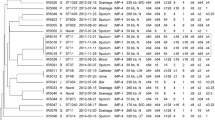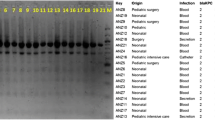Abstract
Carbapenemase-producing Klebsiella pneumoniae has recently spread rapidly throughout China. In this study, we characterized a carbapenem-resistant K. pneumoniae isolate that produced both KPC-2 and IMP-4 type carbapenemases. A clinical isolate of K. pneumoniae, resistant to both meropenem and imipenem, was recovered from a urine sample. Antibiotic susceptibility was determined using the broth microdilution method and Etest (bioMérieux, France). Pulsed-field gel electrophoresis and multilocus sequence typing (MLST) were used for gene type analysis. bla KPC and the encoding genes of ESBLs and plasmid-mediated AmpC enzymes were polymerase chain reaction (PCR) amplified and sequenced. Plasmids were analyzed by transformation, enzyme restriction and Southern blot. PCR analysis revealed that the isolate was simultaneously carrying bla KPC-2, bla IMP-4, bla TEM-1, and bla OKP-B genes. MLST assigned the isolate to a novel sequence type, ST476. bla KPC-2-harbouring plasmids of the isolate and comparative strains had similar EcoRI and HindIII restriction maps, while IMP-4-harbouring plasmids had variable HindIII restriction maps. Coexistence of bla KPC-2 and bla IMP-4 was probably due to bla IMP-4-harbouring plasmid transmission into KPC-2-producing K. pneumoniae (ST476). The concomitant presence of these genes is alarming and poses both therapeutic and infection control problems.



Similar content being viewed by others
References
Queenan AM, Bush K (2007) Carbapenemases: the versatile beta-lactamases. Clin Microbiol Rev 20:440–458
Wei ZQ, Du XX, Yu YS et al (2007) Plasmid-mediated KPC-2 in a Klebsiella pneumoniae isolate from China. Antimicrob Agents Chemother 51:763–765
Pfeifer Y, Cullik A, Witte W (2010) Resistance to cephalosporins and carbapenems in Gram-negative bacterial pathogens. Int J Med Microbiol 300:371–379
Bush K (2010) Alarming beta-lactamase-mediated resistance in multidrug-resistant Enterobacteriaceae. Curr Opin Microbiol 13:558–564
Poirel L, Lagrutta E, Taylor P et al (2010) Emergence of metallo-β-lactamase NDM-1-producing multidrug-resistant Escherichia coli in Australia. Antimicrob Agents Chemother 54:4914–4916
Wu HS, Chen TL, Chen IC et al (2010) First identification of a patient colonized with Klebsiella pneumoniae carrying blaNDM-1 in Taiwan. J Chin Med Assoc 73:596–598
Meletis G, Tzampaz E, Protonotariou E et al (2010) Emergence of Klebsiella pneumoniae carrying bla(VIM) and bla(KPC) genes. Hippokratia 14:139–140
Papagiannitsis CC, Giakkoupi P, Vatopoulos AC et al (2010) Emergence of Klebsiella pneumoniae of a novel sequence type (ST383) producing VIM-4, KPC-2 and CMY-4 beta-lactamases. Int J Antimicrob Agents 36:573–574
Bradford PA, Bratu S, Urban C et al (2004) Emergence of carbapenem-resistant Klebsiella species possessing the class A carbapenem-hydrolyzing KPC-2 and inhibitor-resistant TEM-30 beta-lactamases in New York City. Clin Infect Dis 39:55–60
Dallenne C, Da Costa A, Decré D et al (2010) Development of a set of multiplex PCR assays for the detection of genes encoding important beta-lactamases in Enterobacteriaceae. J Antimicrob Chemother 65:490–495
Queenan AM, Torres-Viera C, Gold HS et al (2000) SME-type carbapenem-hydrolyzing class A beta-lactamases from geographically diverse Serratia marcescens strains. Antimicrob Agents Chemother 44:3035–3039
Radice M, Power P, Gutkind G et al (2004) First class a carbapenemase isolated from Enterobacteriaceae in Argentina. Antimicrob Agents Chemother 48:1068–1069
Aubron C, Poirel L, Ash RJ et al (2005) Carbapenemase-producing Enterobacteriaceae, U.S. rivers. Emerg Infect Dis 11:260–264
Zhao WH, Chen G, Ito R et al (2009) Relevance of resistance levels to carbapenems and integron-borne blaIMP-1, blaIMP-7, blaIMP-10 and blaVIM-2 in clinical isolates of Pseudomonas aeruginosa. J Med Microbiol 58:1080–1085
Levesque C, Piche L, Larose C et al (1995) PCR mapping of integrons reveals several novel combinations of resistance genes. Antimicrob Agents Chemother 39:185–191
Hunter SB, Vauterin P, Lambert-Fair MA et al (2005) Establishment of a universal size standard strain for use with the PulseNet standardized pulsed-field gel electrophoresis protocols: converting the national databases to the new size standard. J Clin Microbiol 43:1045–1050
Naas T, Cuzon G, Villegas MV et al (2008) Genetic structures at the origin of acquisition of the beta-lactamase blaKPC gene. Antimicrob Agents Chemother 52:1257–1263
Shen P, Wei Z, Jiang Y et al (2009) Novel genetic environment of the carbapenem-hydrolyzing beta-lactamase KPC-2 among Enterobacteriaceae in China. Antimicrob Agents Chemother 53:4333–4338
Qi Y, Wei Z, Ji S et al (2011) ST11, the dominant clone of KPC-producing Klebsiella pneumoniae in China. J Antimicrob Chemother 66:307–312
Hawkey PM, Xiong J, Ye H et al (2001) Occurrence of a new metallo-beta-lactamase IMP-4 carried on a conjugative plasmid in Citrobacter youngae from the People’s Republic of China. FEMS Microbiol Lett 194:53–57
Yang Q, Wang H, Sun H et al (2010) Phenotypic and genotypic characterization of Enterobacteriaceae with decreased susceptibility to carbapenems: results from large hospital-based surveillance studies in China. Antimicrob Agents Chemother 54:573–577
Acknowledgement
We acknowledge the Department of Infectious Diseases, Sir Run Run Shaw Hospital (Zhejiang, China) for assistance with the analysis of PFGE patterns.
Funding
This work was supported by a grant from the Ministry of Health of the People’s Republic of China (No.2009ZX10004-107).
Transparency declarations
None to declare.
Author information
Authors and Affiliations
Corresponding author
Rights and permissions
About this article
Cite this article
Wang, Y., Cao, W., Zhu, X. et al. Characterization of a novel Klebsiella pneumoniae sequence type 476 carrying both bla KPC-2 and bla IMP-4 . Eur J Clin Microbiol Infect Dis 31, 1867–1872 (2012). https://doi.org/10.1007/s10096-011-1512-7
Received:
Accepted:
Published:
Issue Date:
DOI: https://doi.org/10.1007/s10096-011-1512-7




